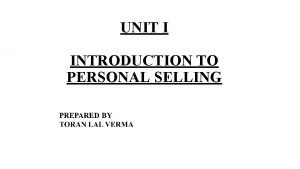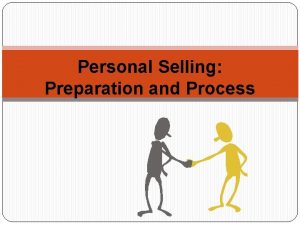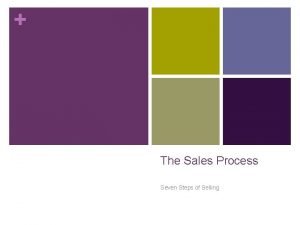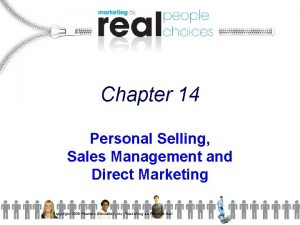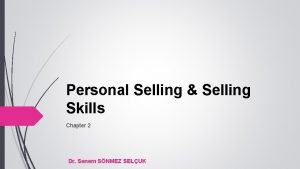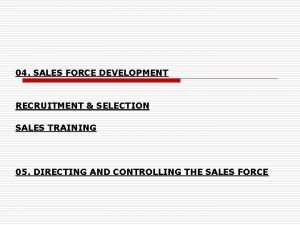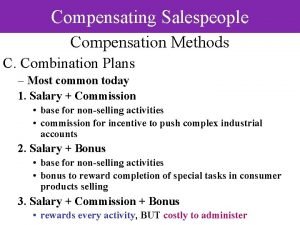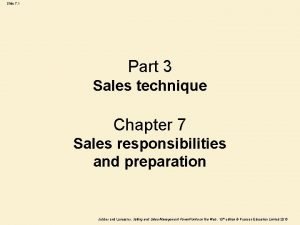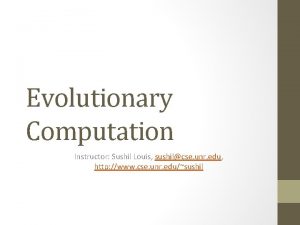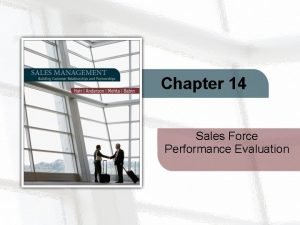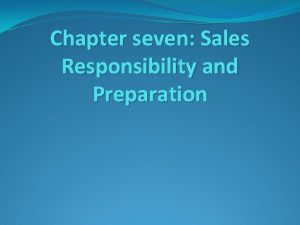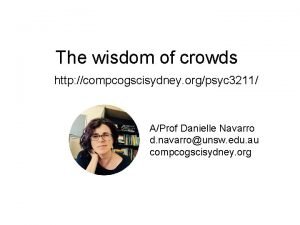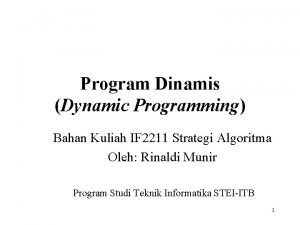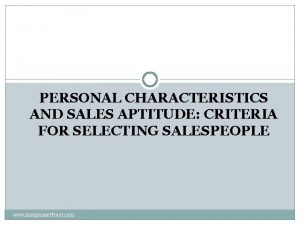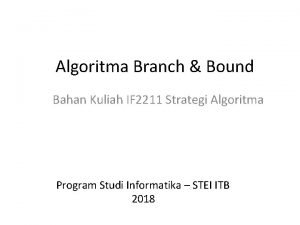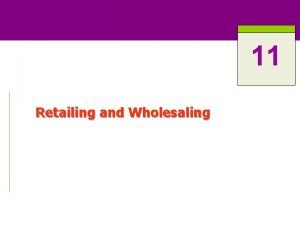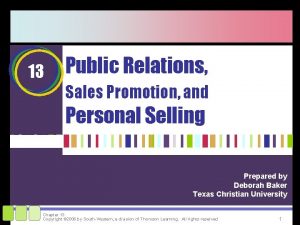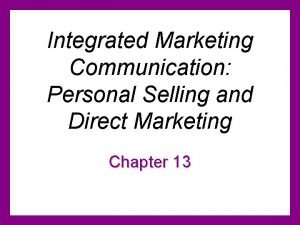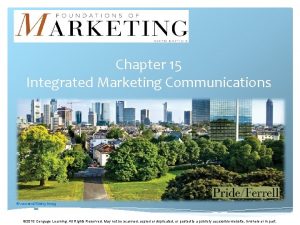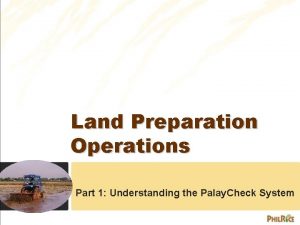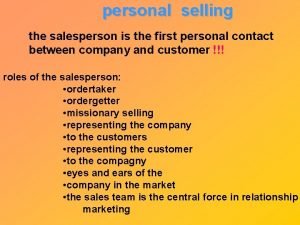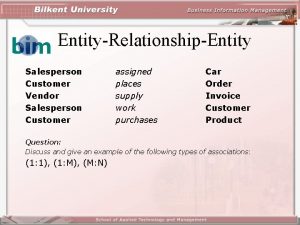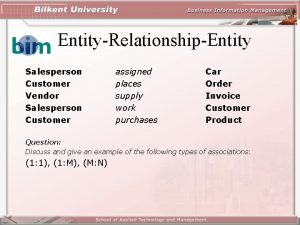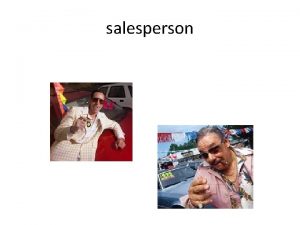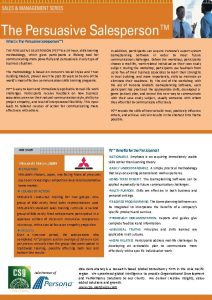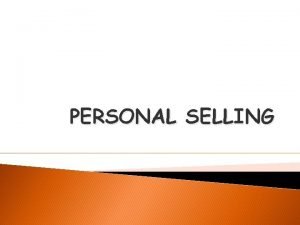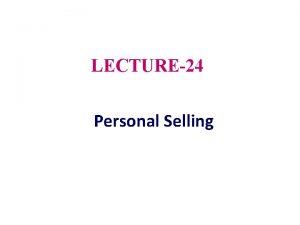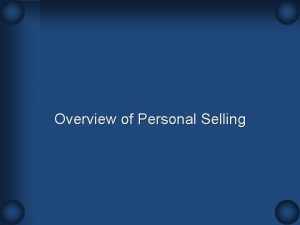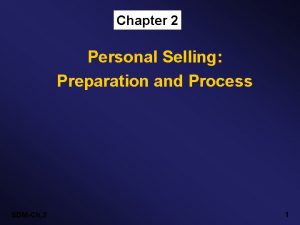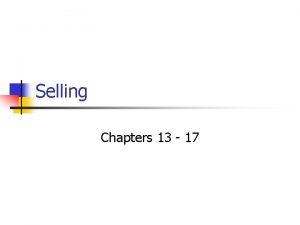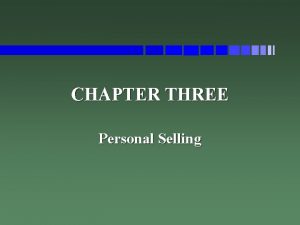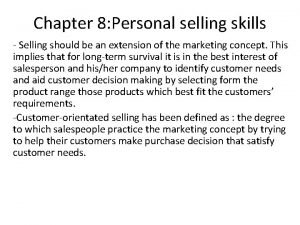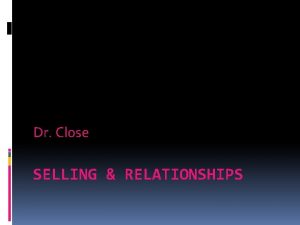Personal Selling Preparation and Process Salesperson Activities Selling























- Slides: 23

Personal Selling: Preparation and Process

Salesperson : Activities Selling activities Non Selling activities (preparation of sales reports, collecting payments, obtaining market information, travelling and waiting to see customers)

FOLLOW UP SERVICE CLOSING THE SALE OVERCOMING OBJECTIONS PRESENTATION AND DEMONSTRATION APPROACH PRE-APPROACH (Precall Planning) PROSPECTING AND QUALIFYING The Personal Selling Process

Prospecting (1) (2) (3) (4) (5) It is identifying or finding prospects i. e. prospective or potential customers. A prospect is not the same as sales lead. Methods of prospecting or sales lead generation are: referrals from existing customers, company sources (website, ads. , tradeshow, teleprospecting), external sources (suppliers, intermediaries, trade associations), salespersons’ networking, industrial directories, (6) cold canvassing

Qualifying Companies qualify sales leads by contacting them by mail or phone to find their interests (or needs) and financial capacity. Necessary conditions for probable prospect: 1. Probable prospect should have need 2. Probable prospect should afford to buy Leads are categorized as: Hot prospects, Warm prospects and Cool prospects Hot (good requirements), Warm (medium requirements), Cool (low requirements) It usually takes about four calls to convert an initial enquiry into sales.

Pre-approach Information gathering about the prospect Sources of information: Internet, industrial directories, government publications, intermediaries, annual reports, trade magazines, suppliers etc. In-depth information about the customer makes salesperson confident. Planning the sales call • Setting call objectives • Planning the sales strategy: - Date, Time, products, features and benefits may meet the customer needs - Adaptive selling (modification to selling objectives or plans)

Approac h Make an appointment to meet the prospect Make favorable first impression Select an approach technique: 1. 2. 3. 4. 5. Introductory (name, company’s name, greeting and a firm handshake) Customer benefit (Identify one major buying motive) Product (Useful when product is new Presentation/Demonstration) Question (Two way communication – make the prospect curious about the product) Praise The approach takes a few minutes of a call, but it can make or break a sale The approaches like free gift may not be liked by some

Presentation and Demonstration There are four components: 1. Understanding the buyer’s needs - Situational questions, Problem identification questions, Problem impact questions, Solution value questions, Confirmation questions. 2. Knowing sales presentation methods / strategies 3. Developing an effective presentation 4. Using demonstration as a tool for selling

a. Understanding the buyer’s needs Situational questions : Questions about the prospects current situation or any facts the salesperson needs Problem identification questions : Uncover the customers problems Problem impact questions : Make the buyers realize the impact or consequences of the problem and the need to solve the problem Solution value questions : Help the buyer assess the value or usefulness of a solution Confirmation questions : for eg Would you be interested to know how our service can minimize the errors in your system?

b. Knowing Sales Presentation Methods/Strategies Stimulus response method / Canned approach. • It is a memorised sales talk or a prepared sales presentation. • The sales person talks without knowing the prospect’s needs. • E. G. Used by tele-marketing people, door to door sales person • Non-technical products Salesperson Provides Stimuli Buyer Responses Sought Continue Process until Purchase Decision

b. Knowing Sales Presentation Methods/Strategies Formula method / Formulated approach/ Mental state selling. • It is also based on stimulus response thinking that all prospects are similar. • Shortcomings are: prospects’ needs are not uncovered and uses same standard formula for different prospects.

b. Knowing Sales Presentation Methods/Strategies (Continued) Need – satisfaction method • Interactive sales presentation • First find prospect’s needs, by asking questions and listening • Use FAB approach: Features, Advantages, Benefits • Effective method as it focuses on customers Uncover and Confirm Buyer Needs Present Offering to Satisfy Buyer Needs Continue Selling until Purchase Decision

b. Knowing Sales Presentation Methods/Strategies • Team selling method - Group presentation

c. Developing an Effective Presentation Some of the guidelines are: Plan the sales call Adapt presentation to the situation and person Benefit Plan Don’t Overload Use the prospect’s language Make the presentation convincing – give evidence Use technology like multi-media presentation

d. Using Demonstration Sales presentation can be improved by demonstration Demonstration is one of the important selling tools EGs: Test drive of cars; demonstration of industrial products in use. Benefits of using demonstration for selling are: • Buyers’ objections are cleared • Improves the buyer’s purchasing interest • Helps to find specific benefits of the prospect • The prospect can experience the benefit Planning and conducting demonstration by rehearsing with colleagues. Contingency plan in case of power failure

Overcoming Sales Objections / Resistances Objections/ Resistance/ Oppositions take place during presentations / when the order is asked. Two types of sales objections: • Psychological / hidden • Logical (real or practical) Methods for handling and overcoming objections: (a) ask questions, (b) turn an objection into a benefit, (c) deny objections tactfully, (d) third-party certificate, (e) compensation (benefits)

Trial close and Closing the sale Trial close checks the attitude or opinion of the prospect, before closing the sale (or asking for the order) If the response to trial close question is favorable, then the salesperson should close the sale. Buying Signals: - Examining product, asking for another’s opinion, asking questions , being friendly. Some of the techniques used for closing the sale are: (a) alternative-choice, (b) minor points, (c) assumptive, (d) summary-of-benefits, (e) T-account, (f) special-offer, (g) probability and (h) negotiation

Closing techniques (a) alternative-choice (prospect is given the (b) (c) (d) (e) (f) choice) minor points (payments in installments, colour, model) Assumptive (starring to wrap, getting credit card machine, asking would you like to take it with you ) summary-of-benefits, T-account- balance sheet close(Assets and Liabilities) special-offer

Negotiatio n When to negotiate? (a) When the buyer puts certain conditions for buying to the seller, (b) When agreement between the buyer and the seller is needed on several factors, (c) When the product is customized, (d) When the final price is to be decided How to prepare for negotiation? (a) planning, (b) building relationship, (c) purpose Styles of negotiation (a) I win, you lose, (b) Both of us win (or win-win style), (c) You win, I lose, and (d) Both of us lose

Follow-up and Service Necessary for customer satisfaction Successful salespeople follow-up in different ways: For example, • Check customer order • Plan follow-up visit at the time of delivery • Account penetration • Relationship marketing

Selling Process in Asian Paints

Selling Process in ICICI BANK

THANK YOU
 Introduction of personal selling
Introduction of personal selling Personal selling activities
Personal selling activities 7 steps sales process
7 steps sales process Personal selling process in sales management
Personal selling process in sales management Personal selling in marketing
Personal selling in marketing Salesforce recruitment and selection process
Salesforce recruitment and selection process Combination plan for salesperson
Combination plan for salesperson Responsibility of salesperson
Responsibility of salesperson Problem question sushil a salesperson
Problem question sushil a salesperson Sales force performance management
Sales force performance management Sales responsibility
Sales responsibility Salesperson
Salesperson Salesperson
Salesperson Salesperson aptitude
Salesperson aptitude Salesperson
Salesperson Types of sports indoor and outdoor
Types of sports indoor and outdoor Primary and support activities
Primary and support activities Primary activities and secondary activities
Primary activities and secondary activities Wholesaler marketing decisions
Wholesaler marketing decisions Tahapan sales cycle
Tahapan sales cycle Personal selling and public relations
Personal selling and public relations Direct marketing and personal selling
Direct marketing and personal selling Personal selling advantages and disadvantages
Personal selling advantages and disadvantages Wetland preparation
Wetland preparation
